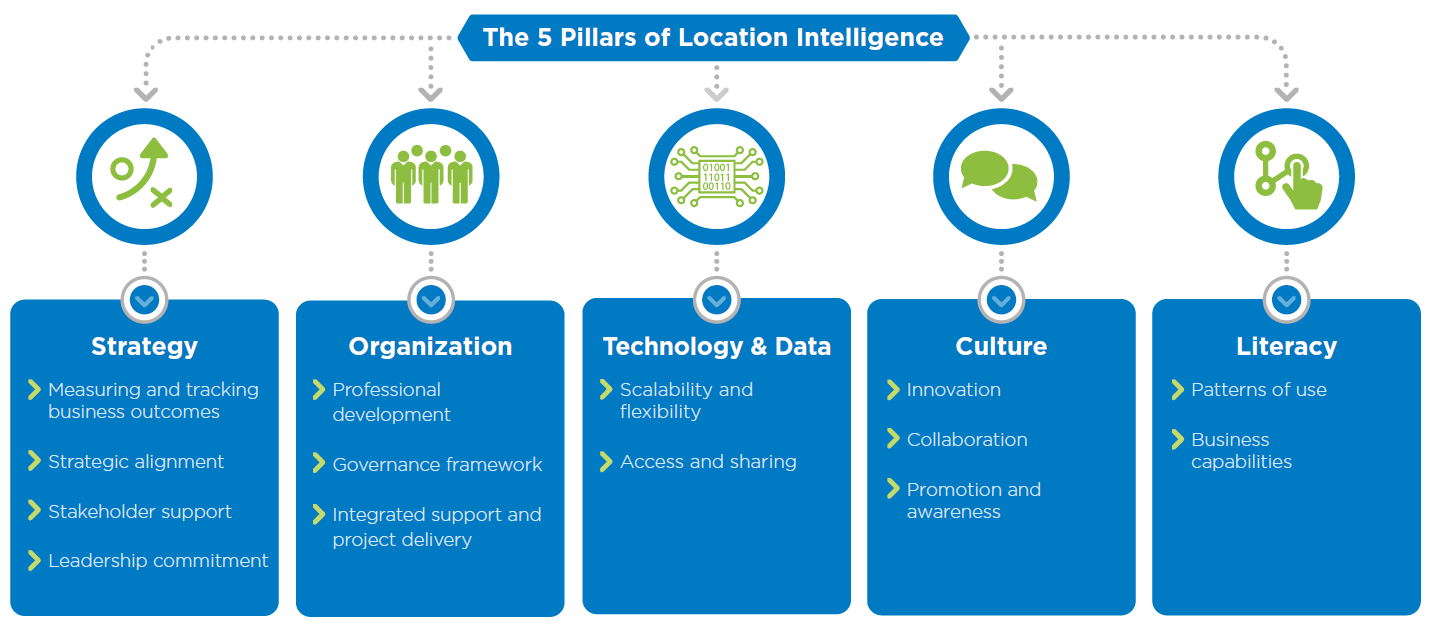In part one of this blog, I touched on the five pillars of location intelligence that help us understand the skills required of an enterprise GIS manager and five important numbers.

The second of my important numbers (64, 76, 78, 84, 84) based on my research of 800+ GIS practitioners across the United State over the last two years, refers to the second pillar of location intelligence, Organisation:
76% of organisations that use GIS do not have formal governance in place.
While Organisation covers many aspects of enterprise GIS, let's focus on Governance. In this context, governance refers to the organisational structure for GIS within the organisation. GIS governance is a critical ingredient for any successful enterprise GIS. If your organisation does not have formal GIS governance, you should consider creating it. Here are some resources to assist:
Matt Lewin, from Esri Canada, has several articles on the subject as well as a presentation video:
You should also reach out to your Esri Account Team for assistance and other examples of successful enterprise GIS governance.
The third of my important numbers mentioned above, refers to the third pillar of location intelligence, Technology & Data:
78% of GIS practitioners have not read the Architecting the ArcGIS Platform: Best Practices document
While Technology & Data covers a wide area, let's focus on Best Practices. This Architecting the ArcGIS Platform: Best Practices document is one of the most important documents produced by Esri, and it is updated at least three times a year. Following and implementing best practices are another key ingredient to a successful enterprise GIS. They are called best practices for a reason. They are designed to help you learn from the missteps of others. Many of the best practices in this document follow those established by the IT industry. By implementing these best practices, your GIS will become stronger, more stable and effective. Please work with your Esri Account Team to implement those that are applicable to your organisation.
The fourth of my important numbers refers to the fourth pillar of location intelligence, Culture:
84% of organisations that use GIS do not have, and maintain, a Change Management Plan
While Culture covers a wide area, let's focus on Change Management. According to Prosci, Change Management is the discipline that guides how we prepare, equip and support individuals to successfully adopt change in order to drive organisational success and outcomes. The biggest challenge for a successful implementation is not the technology, it's the people. The technology is the easy part. You can deploy the best GIS app ever, but if nobody uses it, it's of no value. Change management can really help technology adoption. According to Prosci, organisations that combine a people-focused change management plan with a project plan are up to six times more likely to achieve their project goals. Here are some resources to help you implement Change Management:
-
"Are you talking to me?" The Science of Levels of Organisational Engagement
-
Technology Adoption and Stakeholder Analysis: Organisational Roles
Please work with your Esri Account Team and our Esri Change Management Consulting to learn more about GIS and Change Management.
The fifth of my important numbers refers to the fifth pillar of location intelligence, Literacy:
84% of organisations that use GIS do not have, and maintain, a Workforce Development Plan
While Literacy covers a wide area, let's focus on Workforce Development. GIS is changing rapidly. Everyone that uses GIS in an organisation should be receiving some GIS training annually. Getting financial support for training can be a challenge, as can figuring out what GIS training options to take in what order. As an Esri customer, you have access to an Esri Training Consultant.
These Training Consultants can create a custom workforce development plan for you at no cost. This plan will create learning pathways for each GIS user in your organisation based on their roles, responsibilities and use of ArcGIS technology. Once you have a workforce development plan, it can help you get budget to support this critical need.
There are also a collection of Learning Plans available on the Esri Training website. Contact your Esri Account Team to get connected to your Training Consultant.
Read Part I and Part III of this blog series. You can also discover more ways to get the most out of your GIS by contacting an Esri specialist via email or calling 6742 8622. .

